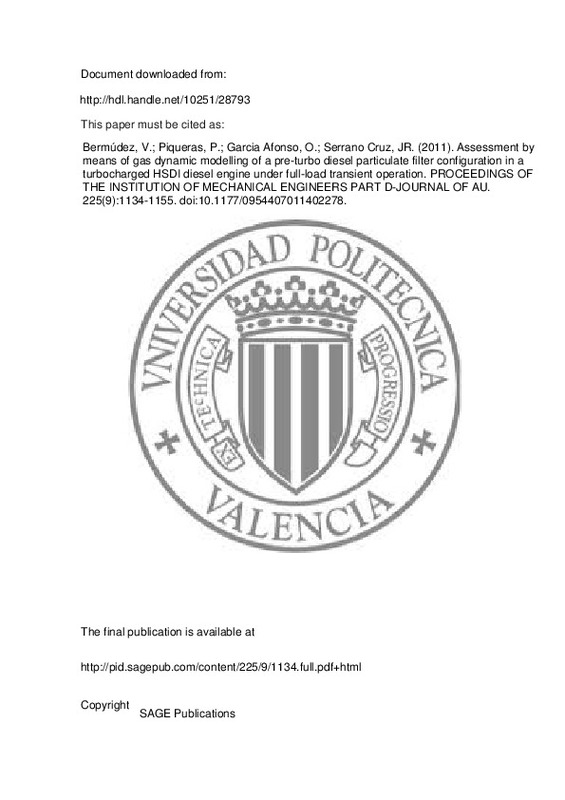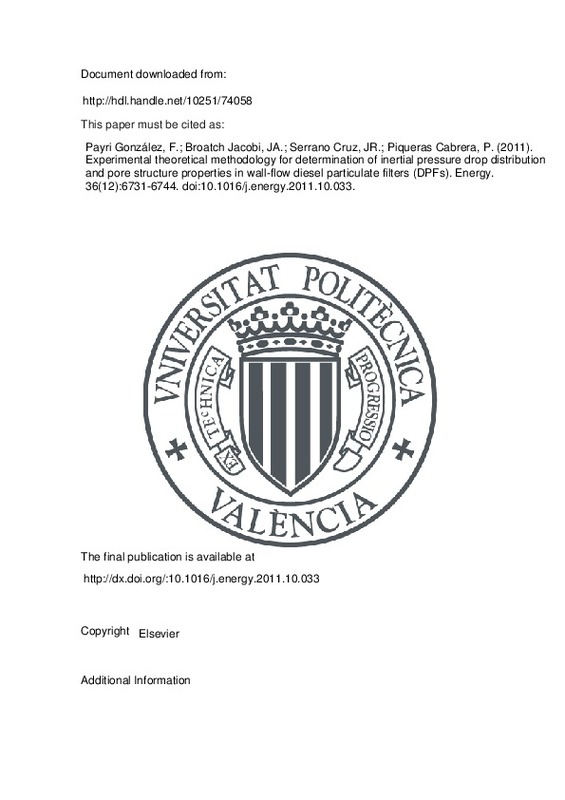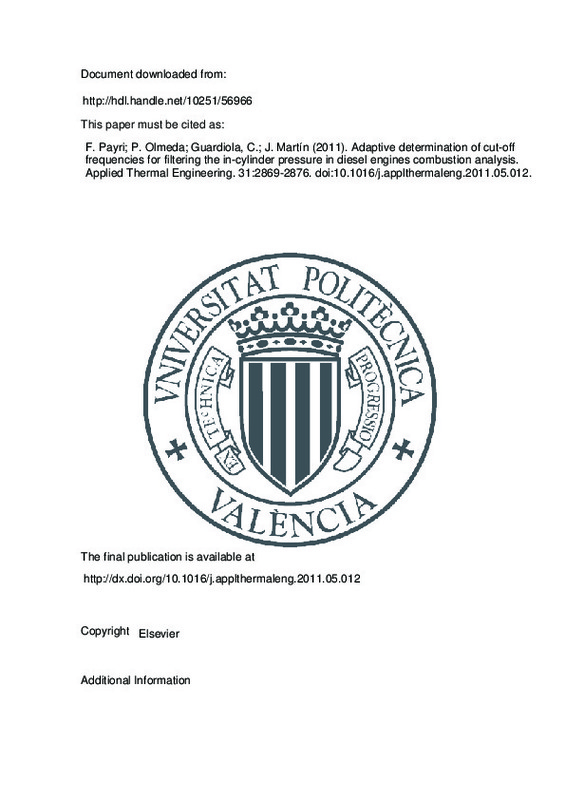JavaScript is disabled for your browser. Some features of this site may not work without it.
Buscar en RiuNet
Listar
Mi cuenta
Estadísticas
Ayuda RiuNet
Admin. UPV
Assessment by means of gas dynamic modelling of a pre-turbo diesel particulate filter configuration in a turbocharged HSDI diesel engine under full-load transient operation
Mostrar el registro sencillo del ítem
Ficheros en el ítem
| dc.contributor.author | Bermúdez, Vicente
|
es_ES |
| dc.contributor.author | Serrano Cruz, José Ramón
|
es_ES |
| dc.contributor.author | Piqueras, P.
|
es_ES |
| dc.contributor.author | García Afonso, Óscar
|
es_ES |
| dc.date.accessioned | 2013-05-13T14:03:24Z | |
| dc.date.issued | 2011 | |
| dc.identifier.issn | 0954-4070 | |
| dc.identifier.uri | http://hdl.handle.net/10251/28793 | |
| dc.description.abstract | Diesel particulate filters (DPF) are becoming a standard technology in diesel engines because of the need for compliance with forthcoming regulations regarding soot emissions. When a great degree of maturity in management of filtration and regeneration has been attained, the influence of the DPF placement on the engine performance emerges as a key issue to be properly addressed. The novelty of this work leads to the study of an unusual location of an aftertreatment device in the architecture of the turbocharged diesel engine exhaust line. The problem of the pre-turbo DPF placement is tackled comparing the engine response under full-load transient operation as opposed to the traditional DPF location downstream of the turbine. The study has been performed on the basis of a gas dynamic simulation of the engine, which has been validated with experimental data obtained under steady-state and transient conditions. The DPF response has been simulated with a model able to deal with the characteristic highly pulsating flow upstream of the turbine. Several levels of DPF soot loading have been considered to represent fully the most exigent conditions in terms of performance requirements. As a result, the main physical phenomena controlling the engine and DPF response and interaction have been identified. Placing the DPF upstream of the turbine will lead to a number of important advantages, owing to the continuous regeneration mode at which the DPF will operate, the lower pressure drop in the DPF, and the thermal energy storage in the DPF, which is very useful to mitigate 'turbocharger lag' during engine transient operation. These three effects have been evidenced with calculations performed using the validated model and the results have been fully analysed and discussed. | es_ES |
| dc.description.sponsorship | This work has been partially supported by the Spanish MCI grant DPI2010-20891-C02-02. | en_EN |
| dc.language | Inglés | es_ES |
| dc.publisher | SAGE Publications | es_ES |
| dc.relation.ispartof | PROCEEDINGS OF THE INSTITUTION OF MECHANICAL ENGINEERS PART D-JOURNAL OF AU | es_ES |
| dc.rights | Reserva de todos los derechos | es_ES |
| dc.subject | Diesel engine | es_ES |
| dc.subject | Diesel particulate filter | es_ES |
| dc.subject | Exhaust line architecture | es_ES |
| dc.subject | Full-load transient test | es_ES |
| dc.subject | Transient operation | es_ES |
| dc.subject | After-treatment | es_ES |
| dc.subject | Diesel particulate filters | es_ES |
| dc.subject | Dynamic modelling | es_ES |
| dc.subject | Engine performance | es_ES |
| dc.subject | Experimental data | es_ES |
| dc.subject | Full-load | es_ES |
| dc.subject | Lower pressures | es_ES |
| dc.subject | Performance requirements | es_ES |
| dc.subject | Physical phenomena | es_ES |
| dc.subject | Pulsating flow | es_ES |
| dc.subject | Soot emissions | es_ES |
| dc.subject | Soot loading | es_ES |
| dc.subject | Standard technology | es_ES |
| dc.subject | Transient conditions | es_ES |
| dc.subject | Turbocharged diesel engine | es_ES |
| dc.subject | Air filters | es_ES |
| dc.subject | Computer simulation | es_ES |
| dc.subject | Exhaust systems (engine) | es_ES |
| dc.subject | Fuel filters | es_ES |
| dc.subject | Gas dynamics | es_ES |
| dc.subject | Gas emissions | es_ES |
| dc.subject | Heat storage | es_ES |
| dc.subject | Machine design | es_ES |
| dc.subject | Particulate emissions | es_ES |
| dc.subject | Regulatory compliance | es_ES |
| dc.subject | Soot | es_ES |
| dc.subject | Turbines | es_ES |
| dc.subject | Diesel engines | es_ES |
| dc.subject.classification | INGENIERIA AEROESPACIAL | es_ES |
| dc.subject.classification | MAQUINAS Y MOTORES TERMICOS | es_ES |
| dc.title | Assessment by means of gas dynamic modelling of a pre-turbo diesel particulate filter configuration in a turbocharged HSDI diesel engine under full-load transient operation | es_ES |
| dc.type | Artículo | es_ES |
| dc.embargo.lift | 10000-01-01 | |
| dc.embargo.terms | forever | es_ES |
| dc.identifier.doi | 10.1177/0954407011402278 | |
| dc.relation.projectID | info:eu-repo/grantAgreement/MICINN//DPI2010-20891-C02-02/ES/ELABORACION DE MODELOS TERMOFLUIDODINAMICOS Y TECNICAS EXPERIMENTALES PARA DESARROLLAR UN COLECTOR DE ESCAPE MULTIFUNCIONAL CON UN FILTRO DE PARTICULAS DIESEL INTEGRADO/ | es_ES |
| dc.rights.accessRights | Abierto | es_ES |
| dc.contributor.affiliation | Universitat Politècnica de València. Departamento de Máquinas y Motores Térmicos - Departament de Màquines i Motors Tèrmics | es_ES |
| dc.description.bibliographicCitation | Bermúdez, V.; Serrano Cruz, JR.; Piqueras, P.; García Afonso, Ó. (2011). Assessment by means of gas dynamic modelling of a pre-turbo diesel particulate filter configuration in a turbocharged HSDI diesel engine under full-load transient operation. PROCEEDINGS OF THE INSTITUTION OF MECHANICAL ENGINEERS PART D-JOURNAL OF AU. 225(9):1134-1155. https://doi.org/10.1177/0954407011402278 | es_ES |
| dc.description.accrualMethod | S | es_ES |
| dc.relation.publisherversion | http://pid.sagepub.com/content/225/9/1134.full.pdf+html | es_ES |
| dc.description.upvformatpinicio | 1134 | es_ES |
| dc.description.upvformatpfin | 1155 | es_ES |
| dc.type.version | info:eu-repo/semantics/publishedVersion | es_ES |
| dc.description.volume | 225 | es_ES |
| dc.description.issue | 9 | es_ES |
| dc.relation.senia | 198857 | |
| dc.contributor.funder | Ministerio de Ciencia e Innovación | es_ES |







![[Cerrado]](/themes/UPV/images/candado.png)



